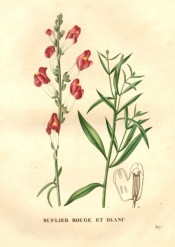Antirrhinum majus L.
Borderline fully hardy perrenial with spikes of showy ‘snapdragon’ flowers in a wide range of colours in summer and autumn. There are many cultivars which are highly variable in habit and size. Individual cultivars may be from 25cm-2m in height and 15-60cm wide. A. majus can be a long-lived border perennial but is usually grown as a bedding annual as it often succumbs to rust if grown for too long. [RHSE, Hortus].
Horticultural & Botanical History
‘From the common Snapdragon, which grows in such spontaneous abundance on old walls and buildings, to the richly tinted kinds which decorate our flower-borders, the variations in the size, form, and colour of the blossoms are so numerous and interfused, that scarcely any race of plants contributes more to our pleasure, in an ornamental point of view. Notwithstanding, however, the profusion of sorts, and the almost interminable extent to which these may be multiplied, varieties are sometimes raised which are so marked in their characteristics as to become garden favourites, and to deserve the perpetuation of their peculiarities.’ [MB p.197/1843].
Early cultivars of Antirrhinum majus were generally tall with large, single flowers in shades of yellow, white and purple. Don describes the colours of A. majus as purple, red, scarlet and white, or variegated with these colours. ‘This is a very polymorphous plant, varying considerably in habit, and much in the colour of the flowers. There is also a variety with double flowers. The leaves in some varieties are variegated.’ ‘A very brief period has as yet been devoted to the improvement of the antirrhinum; and yet the rapid advancement the better and more attractive properties of this flower have made in this short space of time encourages me to hope that we may expect greater distinctiveness and regularity in its stripes and markings than in the carnation or the tulip themselves.’ [Gard. Chron. 1849]. The British Florist figures four varieties: brightii, bright red with a purple tube and yellow thoat; venosa, white, veined with red; lutea, yellow; and atrostriatum, pink and white streaked with red. [BF pl.68/1845]. Paxton’s Dictionary describes seven varieties: bicolor, scarlet and white; caryophylloides, scarlet striped; coccineus, scarlet; flore-pleno, flesh-coloured; quadricolor, red, mauve, purple and yellowish-white; variegated, red; and Youngianum. This latter is figured in Flore des Serres in April 1847 [FS pl.VI 4e Liv./1847], and other named varieties in November of that year. [FS pl.V 11e Liv./1847]. Caryophylloides is figured in Paxton’s Magazine of Botany [MB p.55/1838], as are quadricolor, with flowers of four distinct colours, merging into each other [MB p.197/1843], flore pleno [MB p.99/1844], and Youngianum, pale, rosy-purple flowers, striped with white. ‘A. m. Youngianum, and similar things, are just the subjects for small gardens, or where little space can be spared for flowers, from their being complete in themselves, and not like plants with self-coloured blossoms, requiring those of an opposite hue to create contrast, and throw into view what would otherwise be temporarily hidden.’ [MB p.271/1846].
‘Calves-Snout or Snapdragon. Antirrhinum: A common wild plant in many parts of Europe, and is very frequent in our gardens, and upon the walls of gardens: its natural situation is on hills among barren rocks, and nothing comes so near that, as the top of an old wall with us: the seeds are light and are easily carried by the wind, and they never fail to strike, and the plant flourishes. […] The fresh tops are used; an infusion of them works by urine, and has been recommended by some in the jaundice, and in other diseases arising from obstructions of the viscera; but we have so many English plants that excel in this particular, and the taste of the infusion is so far from agreeable, that it is not worth while to have recourse to it.’ [Hill p.58]. Saint-Hilaire pl.307/1831.
History at Camden Park
Listed in all published catalogues [H.8/1843].
Notes
Published Sep 21, 2009 - 02:24 PM | Last updated Feb 18, 2010 - 05:06 PM
| Family | Scrophulariaceae |
|---|---|
| Category | |
| Region of origin | North-east Spain, Portugal |
| Synonyms | |
| Common Name | Snapdragon |
| Name in the Camden Park Record | Antirrhinum majus |
| Confidence level | high |
